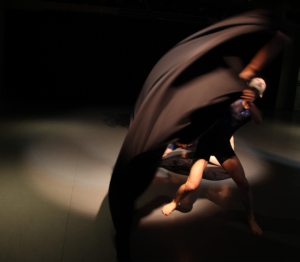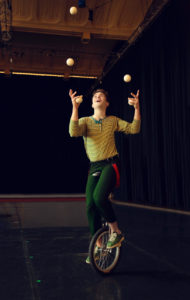By Laurie Cameron, Registered Movement Pattern Analyst

My choreographic process has always involved collaborative research – studio time in which “problems” that I have invented (usually based on a theme) are solved in various ways by the artists who will eventually perform whatever eventually materializes. As the director of the process, my job is to organize and orchestrate largely improvised material into some kind of coherent, presentable form.
With strong motivations in both Timing and Anticipating, it has always been important to me to move the process toward a “finished product” in a timely fashion, assuming that all involved trusted me to make sound artistic decisions and hoping to avoid hours of grueling studio work that might not necessarily produce more interesting results.
During my Movement Pattern Analysis training, I had the opportunity to profile three movement artists – a traditional, highly trained modern dancer, a B-Boy, and a Corporeal Mime practitioner. I was impressed by the diversity of their skills, their interest in self-growth, and their willingness to dive headlong into the choreographic unknown with me. I was even more intrigued by the profile initiatives that they shared, particularly high Investigating and Evaluating, and low-to-moderate Commitment. At the time I anticipated the challenge of moving them out of the Attention and Intention stages to commit to a final product. I did not expect to lose control of the process in such a meaningful and productive way.
I had anticipated three months of studio research followed by an informal showing, more editing, and eventually a fully realized performance about six months later. Instead, the energy to dig deeply, evaluate, reinvent and reimagine took over. All three performers seemed perfectly happy to mine material and critically assess for hours at a time with no performance agenda in sight. For me, the satisfaction of watching the work grow deeper and more refined validated the assessment process. I found my own moderate Evaluating being nourished while my urge to push the piece to completion seemed to relax. We worked in the studio for more than a year before my urge to set a finished piece took hold.
Of all the works I have directed, I am proudest of this. The images suggested by the myths of the Black Sea are, to me, fully realized, and the performers are deeply in tune with each other and with the material they grew with for so long. This process would likely have followed the same course regardless of my knowledge of MPA, but the awareness I now have of the potential for fruitful creative interaction based on decision-making preferences can inform my choreographic process in ways I had never predicted.
 Over the past six years, I have been part of an interdisciplinary research team testing Movement Pattern Analysis (MPA). The team consists of movement analysts, political scientists, and psychologists. We have been comparing the Movement Pattern Analysis profiles of a participant group of military officers with their performance on a set of decision-making tasks completed in a laboratory situation. Our aim is to assess how well their MPA profiles correlate with their decision-making behaviors in the lab.
Over the past six years, I have been part of an interdisciplinary research team testing Movement Pattern Analysis (MPA). The team consists of movement analysts, political scientists, and psychologists. We have been comparing the Movement Pattern Analysis profiles of a participant group of military officers with their performance on a set of decision-making tasks completed in a laboratory situation. Our aim is to assess how well their MPA profiles correlate with their decision-making behaviors in the lab.
 Movement Pattern Analysis is based on the premise that patterns of body movement reflect cognitive processes involved in making decisions. This premise usually is met with skepticism, for at the level of popular consciousness, mind and body are still separate entities.
Movement Pattern Analysis is based on the premise that patterns of body movement reflect cognitive processes involved in making decisions. This premise usually is met with skepticism, for at the level of popular consciousness, mind and body are still separate entities. Mastery of Movement is for body and effort what Choreutics is for space and shape – the most comprehensive treatment of Laban’s ideas in English. The book has an interesting history.
Mastery of Movement is for body and effort what Choreutics is for space and shape – the most comprehensive treatment of Laban’s ideas in English. The book has an interesting history. Long before diversity became a political issue, Warren Lamb was encouraging diversity in management teams. His model of diversity was not based on age, race, creed, or gender. Rather it was based on decision-making style.
Long before diversity became a political issue, Warren Lamb was encouraging diversity in management teams. His model of diversity was not based on age, race, creed, or gender. Rather it was based on decision-making style. In his observation and analysis of thousands of business executives,
In his observation and analysis of thousands of business executives,  Shortly after I completed my Laban Movement Analysis training (1976), Warren Lamb gave a short course at the Dance Notation Bureau. I had been thinking a lot about the relationship between movement and psychology, but in vague and hypothetical ways. What Lamb presented was much more concrete — it blew me away.
Shortly after I completed my Laban Movement Analysis training (1976), Warren Lamb gave a short course at the Dance Notation Bureau. I had been thinking a lot about the relationship between movement and psychology, but in vague and hypothetical ways. What Lamb presented was much more concrete — it blew me away. In 2011, I participated in a pilot study examining the validity of Movement Pattern Analysis profiles in predicting decision-making patterns. Although MPA has been used by senior business teams for over 50 years, its potential application to the study of military and political leaders has barely been tapped. The pilot study was the first test of this new area of application.
In 2011, I participated in a pilot study examining the validity of Movement Pattern Analysis profiles in predicting decision-making patterns. Although MPA has been used by senior business teams for over 50 years, its potential application to the study of military and political leaders has barely been tapped. The pilot study was the first test of this new area of application.
 In the 1940s, Rudolf Laban took his dance theories into the world of work, addressing issues of efficiency, job satisfaction, and reduction of fatigue on the factory floor.
In the 1940s, Rudolf Laban took his dance theories into the world of work, addressing issues of efficiency, job satisfaction, and reduction of fatigue on the factory floor. The very first time we encounter a stranger, we derive an impression based on the person’s physical attributes and body language. Then rapidly and without conscious or logical control, we form a judgment – is the person positive, negative, or neutral?
The very first time we encounter a stranger, we derive an impression based on the person’s physical attributes and body language. Then rapidly and without conscious or logical control, we form a judgment – is the person positive, negative, or neutral?